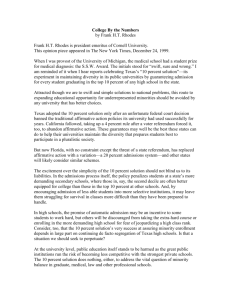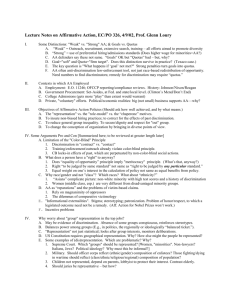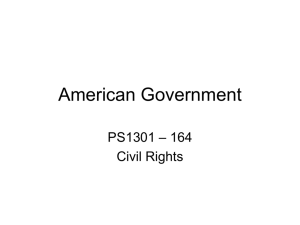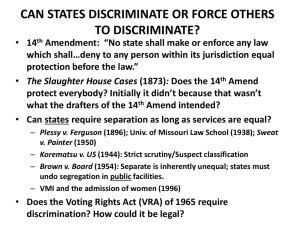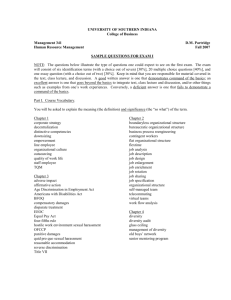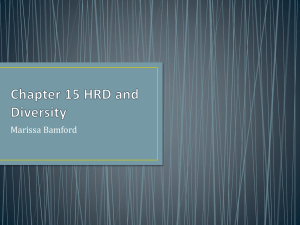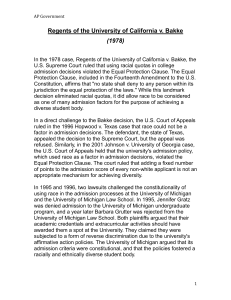Documents - SALAZAR'S SOCIAL STUDIES
advertisement
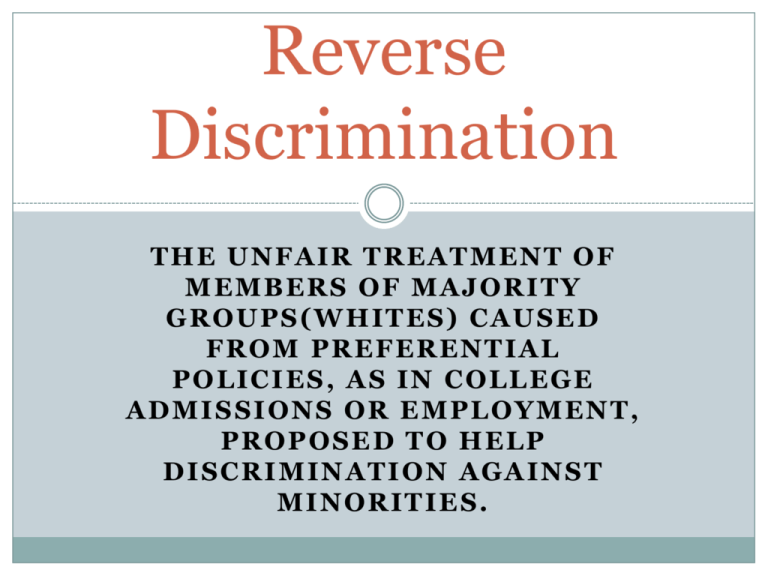
Reverse Discrimination THE UNFAIR TREATMENT OF MEMBERS OF MAJORITY GROUPS(WHITES) CAUSED FROM PREFERENTIAL POLICIES, AS IN COLLEGE ADMISSIONS OR EMPLOYMENT, PROPOSED TO HELP DISCRIMINATION AGAINST MINORITIES. Fullilove v Klutznick Fullilove v. Klutznick, was a case in which the United States Supreme Court held that the U.S. Congress could constitutionally use its power to past discrimination. Congress had passed a law that required that at least 10 percent of federal funds given to local public works programs should be used for services or supplies for businesses owned by minority group members. H. Earl Fullilove and other contractors decided to sue, claiming they had been economically harmed by the legislation congressed passed. Adarand Constructions v Pena was a case in which the United States Supreme Court decided that federal programs that classified people by race, even if it was to extend opportunities for minorities, should be recognized as unconstitutional. This case allowed courts to apply criteria’s for the affirmative action programs similar to those applied to racial classifications. This case did not get rid of affirmative action programs but it did limit the impact they were intended to make. This case also overturned the decision made in Fullilove v Klutznick. University of California v Bakke was a case in which the United States Supreme Court decided that a state university could not admit less qualified individuals only because of their race. Allan Bakke sued Davis saying that the university had denied him equal protection because of his race. The court decided that the university did discriminate against him because of his race. The court didn’t order UC Davis to never again use race to admit there students. The court said that they could adopt an admission program which race was one factor of acceptance but had to be used fairly with other elements. The school could not set aside spots for a certain type of group. Affirmative Action is a policy for members of some previously disadvantaged group. Affirmative Action involves efforts to bring about increased employment and promotion. The goal is to move beyond equal opportunities toward equal results. The case began in 1992, when Cheryl Hopwood was denied admission to the University of Texas Law School despite being better qualified than many admitted minority candidates. The Fifth Circuit Court of Appeals ruled in her favor four years later. The court stated that the 14th Amendment forbids state universities from using race as a factor in admissions. As a result, The Supreme Court got rid of affirmative action in admissions in Texas, Louisiana and Mississippi. Preferential treatment is sometimes viewed as reverse discrimination. It occurs whenever a person receives a benefit because he or she is of the "correct" race, gender, economic status, religious affiliation or other categorization. An employer may not be allowed by law to discriminate against any applicant protected under law, but he or she can still show preferential treatment towards applicants who meet certain unspoken standards. Preferential treatment can also be translated as a positive form of discrimination, in which a person actually receives better treatment based on his or her gender, race or age. This was a court case in North Carolina. North Carolina had more than 84,000 students in schools during the 1960’s. 29% were Negro; about 14,000 attended 21 schools that were at least 99% Negro. The District Court ordered the school board to provide a plan for desegregation in students and faculty. They came up with various plans but could not agree to establish one, so the court decided that if the board did not come up with one the one best one presented to them would stay in place. To this day this is practice: -Eliminate from the public schools all vestiges of state-imposed segregation. Equal protection guarantees by Brown v. Board of Education -School authorities’ obligation to offer remedies, the district courts gave the broad power to fashion remedies that will assure unity in school systems. -Title IV of the Civil Rights Act of 1964 does not restrict from the federal courts and -their historic equitable remedial powers. -Policy and practice with regard to faculty, staff, transportation, extracurricular activities, and facilities are important to segregated system, and the first remedial responsibility of school authorities is to eliminate racial distinctions in those respects. -The Constitution does not prohibit district courts from using their equity power to order assignment of teachers to desegregation. Jennifer Gratz & Patrick Hamacher applied to Michigan as residents of the State of Michigan, but were rejected. Filed lawsuit based on violation of EPC of 14th Amendment. The university implements a point system. This point system is out of 100 points., and a minority applicant was entitled to 20 extra points in their admissions formula. They would have qualified for admission if they were minorities, but did not because they were white CASE In 1997, Barbara Grutter, a white resident of Michigan, applied for admission to the University of Michigan Law School. She was denied admission Grutter is a so-called "reverse discrimination" lawsuit in which the Center for Individual Rights challenges the affirmative action program at the University of Michigan Law School REVERSE DISCRIMINATION Barbara Grutter applied for admission to the University of Michigan Law School with a personal right guaranteed by the Constitution that she would not have her race counted against her The law school intentionally disregarded that right by discriminating against her on the basis of race as it does each year in the case of thousands of individuals who apply for admission The law school defends its practice of race discrimination as necessary to achieve a diverse student body. In November 1996, California voters passed the California Civil Rights Initiative, more commonly known as Proposition 209. Prohibits the state, local governments, districts, public universities, colleges, and schools, and other government instrumentalities from discriminating against or giving preferential treatment to any individual or group in public employment, public education, or public contracting on the basis of race, sex, color, ethnicity, or national origin.
